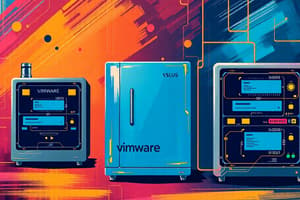Podcast
Questions and Answers
What is the primary function of a hypervisor in a Virtual Resource Pool?
What is the primary function of a hypervisor in a Virtual Resource Pool?
- To manage database transactions
- To allocate physical machines for IoT applications
- To configure network connectivity between VMs
- To provide an operating system environment for virtual machines (correct)
Which type of database is preferred for real-life IoT applications?
Which type of database is preferred for real-life IoT applications?
- Relational database systems
- In-memory databases
- NoSQL databases (correct)
- Hierarchical databases
What is one of the main benefits of using load-balancing servers in IoT Cloud?
What is one of the main benefits of using load-balancing servers in IoT Cloud?
- They operate as standalone servers for IoT applications
- They only process requests without managing workloads
- They ensure uniform resource distribution and avoid server congestion (correct)
- They increase the number of physical machines available
Which of the following virtualization platforms is preferred for accessing computing and memory resources?
Which of the following virtualization platforms is preferred for accessing computing and memory resources?
What component of a Virtual Resource Pool provides hardware resources?
What component of a Virtual Resource Pool provides hardware resources?
Which application domain of IoT cloud platform focuses on analyzing data drawn from devices?
Which application domain of IoT cloud platform focuses on analyzing data drawn from devices?
In the context of IoT Cloud, why is dynamic resource allocation important?
In the context of IoT Cloud, why is dynamic resource allocation important?
What is a fundamental characteristic of NoSQL databases in IoT applications?
What is a fundamental characteristic of NoSQL databases in IoT applications?
What type of servers can be implemented as Virtual Machines (VMs)?
What type of servers can be implemented as Virtual Machines (VMs)?
What is one of the roles of load-balancing servers in an IoT Cloud environment?
What is one of the roles of load-balancing servers in an IoT Cloud environment?
Flashcards are hidden until you start studying
Study Notes
Virtualization Platform Overview
- Essential for creating a Virtual Resource Pool composed of multiple Virtual Machines (VMs).
- Hypervisor enables direct management of physical machine CPU and memory resources.
Components of the Virtual Resource Pool
- Comprises hardware resources (CPUs, memory, and network connectivity) on physical servers.
- Hypervisor software facilitates the operating system environment for VMs and dynamic resource allocation.
Hypervisor and Virtual OS
- VMware vSphere is the preferred hypervisor for accessing physical computing and memory resources.
- Supports the deployment of IoT Cloud services on VMs, ensuring high performance at reduced costs.
Data Storage in IoT Applications
- Data from IoT applications can be stored in either SQL (relational) or NoSQL (non-relational) databases.
- NoSQL databases are favored for real-time IoT applications due to their suitability for complex data types and scalability.
Importance of Load-Balancing Servers
- Process requests systematically to enhance performance.
- Distribute workloads across application and database servers effectively.
- Prevent congestion, maximizing productivity and resource utilization.
Application Domains of IoT Cloud Platform
- Encompasses various domains including:
- Application development
- Device management
- Virtualization
- Research and analytics
- Deployment management
- Data management
- Monitoring management
- Heterogeneity management
- System management
Studying That Suits You
Use AI to generate personalized quizzes and flashcards to suit your learning preferences.




